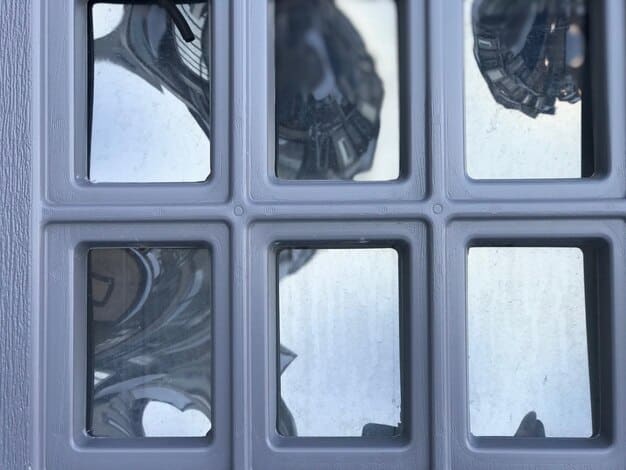Energy-Efficient Windows: Save Money & Reduce Heat Loss by 40%

Energy-efficient windows, incorporating innovations like low-E coatings and multiple panes, significantly cut heat loss—often by 40% or more—leading to substantial savings for US homeowners on energy bills while enhancing comfort and reducing environmental impact.
Are you tired of high energy bills and drafty rooms? Investing in energy-efficient windows is a smart move that can save you money and increase the comfort of your home. New technologies are transforming windows, making them far more effective at reducing heat loss and keeping your home cozy year-round. For US homeowners, this means significant savings and a smaller carbon footprint.
Energy-Efficient Windows: Understanding the Basics
Energy-efficient windows aren’t just about glass; they involve a sophisticated combination of materials and designs working together. Before diving into the latest technologies, it’s crucial to understand the core components that make these windows so effective. This foundation will help you appreciate how new innovations maximize energy savings.
Key Components of Energy-Efficient Windows
Several key components contribute to the overall energy efficiency of a window. These include the type of glass used, the frame material, and the gas fill between the panes. Each element plays a vital role in minimizing heat transfer.
- Low-E Coatings: Thin, transparent coatings that reduce the amount of infrared and ultraviolet light that can pass through the glass.
- Multiple Panes: Windows with two or three panes of glass create insulating air spaces that prevent heat transfer.
- Gas Fills: Filling the space between the panes with inert gases like argon or krypton further reduces heat conduction.
Understanding these basics is essential for choosing the right windows for your home. Each component contributes to a window’s overall energy performance, measured by factors like U-factor and Solar Heat Gain Coefficient (SHGC). Knowing what these terms mean will empower you to make informed decisions.

New Technologies Reducing Heat Loss
Advancements in window technology have led to significant reductions in heat loss. Innovations in glass coatings, frame materials, and window design are all contributing to more energy-efficient homes. These new technologies aim to minimize thermal bridging and maximize insulation.
Advanced Glazing Options
One of the most significant advancements in window technology is the development of advanced glazing options. These include dynamic glass, which can adjust its tint based on sunlight, and spectrally selective coatings, which allow visible light to pass through while blocking infrared radiation.
Dynamic glass offers the highest SHGC during winter and the lowest SHGC during summer. Coatings are optimized for different orientations. For example, you can pick coatings that allow for more passive solar heating during the winter.
Insulated Frames: Materials and Design
The frame material is just as important as the glass itself. Modern windows use innovative frame materials like fiberglass, composite, and vinyl, which offer superior insulation properties compared to traditional aluminum frames. These frames also incorporate thermal breaks to further reduce heat transfer.
- Fiberglass: Strong, durable, and resistant to temperature changes, making it an excellent insulator.
- Composite: Made from a combination of wood and plastic, offering a balance of insulation and aesthetics.
- Vinyl: Affordable, low-maintenance, and provides good insulation, especially when filled with foam.
New technologies are dramatically improving the ability of windows to retain heat during winter and block heat during summer. These advancements are translating to significant energy savings and increased comfort for homeowners.
Measuring Window Energy Efficiency: Key Metrics
Understanding the key metrics for measuring window energy efficiency is crucial for making informed purchasing decisions. Two of the most important metrics are the U-factor and the Solar Heat Gain Coefficient (SHGC). These ratings provide insight into how well a window insulates and controls solar heat gain.
The National Fenestration Rating Council (NFRC) is the governing body that certifies windows. You can find energy performance labels on newly purchased windows indicating U-Factor and Solar Heat Gain Coeficient, as well as Visible Transmittance and Air Leakage.
Here are the key metrics explained:
- U-Factor: Measures how well a window insulates. Lower U-factors indicate better insulation, meaning less heat loss in winter and less heat gain in summer. Ranges from 0.20 to 1.20.
- Solar Heat Gain Coefficient (SHGC): Measures how much solar radiation a window allows to enter a room. Lower SHGC values mean less solar heat is admitted, which is beneficial in hot climates. Ranges from 0 to 1.
- Visible Transmittance (VT): Measures how much visible light comes through a window. The higher VT is, the more natural light. Ranges from 0 to1.

Cost Savings for US Homeowners
Investing in energy-efficient windows can lead to substantial cost savings for US homeowners. By reducing heat loss and improving insulation, these windows can lower energy bills and provide a return on investment over time. The exact amount of savings depends on various factors, including climate, window size, and the efficiency of existing windows.
Estimating Potential Savings
The savings from energy-efficient windows can vary depending on the climate zone and the efficiency of the windows they replace. In colder climates, the savings are primarily due to reduced heat loss, while in warmer climates, the savings come from reduced solar heat gain. A qualified energy auditor can provide localized savings estimates.
Long-Term Financial Benefits
The long-term financial benefits of energy-efficient windows extend beyond just lower energy bills. These windows can increase the value of your home, making it more attractive to potential buyers. They also require less maintenance than older windows, saving you time and money on repairs.
Many energy company offers rebates for installing energy efficient windows, so it’s worth investigating.
By carefully considering these factors, homeowners can make informed decisions about investing in energy-efficient windows and reap the financial rewards for years to come.
Installation and Maintenance Tips
Proper installation and maintenance are crucial for ensuring the long-term performance of energy-efficient windows. Even the highest-quality windows will not perform as expected if they are not installed correctly. Regular maintenance can also extend the lifespan of your windows and keep them operating efficiently.
Professional vs. DIY Installation
While some homeowners may be tempted to install windows themselves, professional installation is often the best choice. Professionals have the expertise and equipment to ensure that windows are properly sealed and aligned, preventing air leaks and maximizing energy efficiency. Improper installation can void warranties and lead to costly repairs.
Extending Window Lifespan
Regular maintenance can extend the lifespan of your windows and keep them operating efficiently. This includes cleaning the glass and frames, inspecting seals and caulking, and addressing any issues promptly. Simple steps like these can prevent minor problems from becoming major repairs.
Here’s some things to keep in mind when taking care of your windows:
- Clean regularly: Use mild soap and water to clean the glass and frames.
- Inspect seals: Check for cracks or gaps in the seals and caulking.
- Lubricate hardware: Keep hinges and locks lubricated for smooth operation.
Comparing Window Options: What to Look For
With so many window options available, it can be challenging to choose the right ones for your home. Comparing different types of windows based on their energy efficiency, cost, and aesthetic appeal is essential for making an informed decision. Consider your budget, climate, and architectural style when selecting windows.
Energy Efficiency Comparison
When comparing window options, pay close attention to the energy efficiency ratings. Look for windows with low U-factors and SHGC values that are appropriate for your climate. Also, consider the air leakage rating, which indicates how much air can pass through the window. Lower air leakage ratings are better.
Aesthetics to Consider
The aesthetic appeal of windows is also an important consideration. Choose window styles and frame materials that complement your home’s architectural style. Consider factors like color, finish, and hardware when making your selection. Windows can significantly impact the overall look and feel of your home.
Keep these points in mind when shopping around for energy-efficient windows:
- Climate Considerations: Choose windows designed for your specific climate.
- Aesthetic Preferences: Select windows that match your home’s style.
- Budget Constraints: Balance cost with performance to maximize value.
| Key Point | Brief Description |
|---|---|
| 💰 Cost Savings | Energy-efficient windows lower utility bills. |
| 🔥 Heat Loss | New tech reduces heat loss by up to 40%. |
| 🛡️ Key Metrics | U-factor and SHGC measure efficiency. |
| 🛠️ Installation | Professional install ensures peak performance. |
Frequently Asked Questions
▼
Low-E coatings reduce the amount of infrared and ultraviolet light that passes through the glass. This helps keep heat inside during winter and outside during summer, lowering energy costs.
▼
U-factor measures how well a window insulates: lower is better. SHGC measures how much solar radiation a window allows to enter: lower values are preferable in warmer climates to reduce heat gain.
▼
Yes, energy-efficient windows are worth the investment for most homeowners. They can reduce energy bills, increase home value, and improve comfort. The long-term financial and environmental benefits outweigh the initial cost.
▼
You should clean and inspect your windows at least twice a year. Check for any cracks, gaps, or damages in the seals and caulking around the window frames. Lubricate the hardware to ensure long-lasting performance.
▼
While DIY installation is possible, professional installation guarantees a proper and sealed fit while preventing air leaks. Poor installation can void the warranty, counteracting the benefits of energy efficiency technology.
Conclusion
Investing in energy-efficient windows is a smart long-term strategy for US homeowners looking to significantly reduce heat loss, lower energy bills, and enhance their home’s comfort. With the latest technologies reducing heat loss by up to 40%, upgrading your windows is a worthwhile investment that pays off in both financial savings and environmental benefits.





